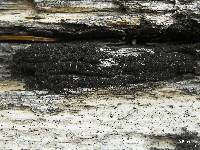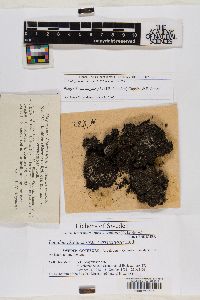
Consortium of Lichen Herbaria
- building a Global Consortium of Bryophytes and Lichens as keystones of cryptobiotic communities -
- Home
- Search
- Images
- Species Checklists
- US States: O-Z >
- US National Parks
- Central America
- South America
- US National Parks
- Southern Subpolar Region
|
|
|
|
Family: Trapeliaceae
[Lecidea oligotropha J.R. Laundon, moreLecidea uliginosa var. verruculosa Hedl., Saccomorpha oligotropha (J.R. Laundon) Clauzade & Cl. Roux] |
Nash, T.H., Ryan, B.D., Gries, C., Bungartz, F., (eds.) 2004. Lichen Flora of the Greater Sonoran Desert Region. Vol 2. Thallus: crustose, well developed, +contiguous or dispersed, coarsely granular-verrucose granules: rounded, convex to subcoralloid, 100-300 µm in diam., noticeably more prominent when wet surface: tawny brown or dark olive- to red-brown, dull, often tinged yellowish green when wet Apothecia: numerous, commonly dense and contiguous, rounded, sessile to immersed in verrucules, (0.2-)0.4-0.5(-0.8) mm in diam. disc: very dark red-brown to brownish black, at first concave to plane, occasionally becoming convex, rugose-roughened, dull margin: usually persistent as the disc expands exciple: deep red-brown or brown to blackish brown, extending into hypothecium, thin, +elevated, persistent or disappearing, pseudoparenchymatous, with cells up to 17-18 x 10-12 µm, partly carbonized epihymenium: brown hymenium: hyaline, yellowish, pale yellow, or pale reddish brown, 55-80 µm tall, I+ reddish orange; paraphyses: much-branched, 1-1.5 µm wide below, with tips up to 7 µm wide, often browncaptiate hypothecium: yellowish brown to brown-black below, I+ reddish orange asci: clavate, 8-spored ascospores: hyaline, simple (to 1-septate), ellipsoid, (8-)10-14(-16) x 4.5-6(-8) µm Spot tests: thallus K-, C-, KC-, P-, I- Secondary metabolites: none detected. Substrate and ecology: usually on peaty soil or humus, in open areas, often around old stumps, sometimes on decaying wood, but never on bark World distribution: circumpolar boreal to subalpine in Europe, Asia, and North America Sonoran distribution: upper montane areas of Arizona. Notes: Placynthiella oligotropha is distinguished from other species in the genus by its larger granules, that become noticeably more prominent and pale olive-brown when wet. It is very close to P. uliginosa and often grows with it, but, in addition to having larger granules, has a more tawny thallus and larger cells in the exciple. |
|
|
|
Powered by Symbiota



































































